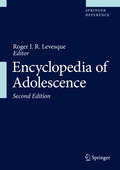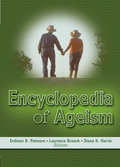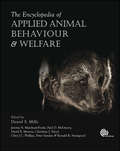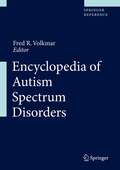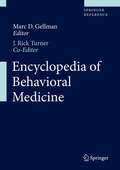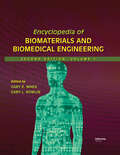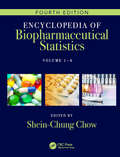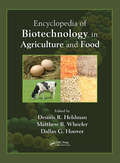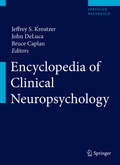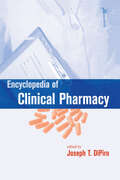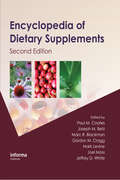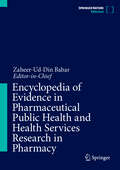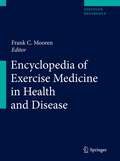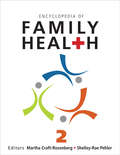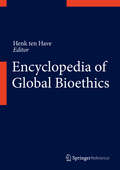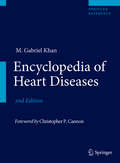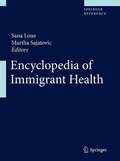- Table View
- List View
Encyclopedia of Adolescence
by Roger J.R. LevesqueThe second edition of this encyclopedia continues to break new ground as an important resource for the study of adolescence. Comprehensive in breath and textbook in depth, the second edition – with entries presented in easy-to-access A to Z format – serves as a reference repository of knowledge in the field as well as a frequently updated conduit of new research and knowledge long before such information trickles down to standard textbooks. This updated and expanded major reference work advances the field by pushing and creating new boundaries and areas of study that further our understanding of adolescents and their place in society. In addition to the original 730 entries, the new edition adds more than 200 new essays as well as updates to many other entries. Substantively, the second edition continues to draw from four major areas of research relating to adolescence:The first broad area includes research relating to "Self, Identity and Development in Adolescence"The second broad area centers on "Adolescents’ Social and Personal Relationships".The third area examines "Adolescents in Social Institutions"."Adolescent Mental Health" constitutes the last major area of research.This unique, comprehensive second edition of the Encyclopedia of Adolescence is an essential reference for advanced undergraduate and graduate students as well as researchers, professors, clinicians, and other practitioners across such related disciplines as developmental psychology, criminology and criminal Justice, adolescent psychiatry, child and school psychology, family, and public health.
Encyclopedia of Ageism
by Diana K. Harris Erdman B. Palmore Laurence BranchLearn more about age discrimination and how it affects us allThe Encyclopedia of Ageism is a comprehensive review of over 125 aspects of ageism, alphabetically arranged for easy access. Written by 60 experts, the book examines topics such as anti-aging, stereotypes, and the media-with numerous references for further information. You'll find an alphabetical list of the entries, a detailed index, and a list of the entries categorized by subject, to help you find what you need fast. This resource will increase your awareness about the many facets of ageism and provide you with a wealth of concepts, theories, and facts about ageism. This important resource exposes the many faces of dehumanization through the elder neglect and prejudice that results from today's worldwide youth-oriented culture. The Encyclopedia of Ageism will help you recognize ageism when you encounter it and avoid it in your own thinking and actions. The book is a valuable guide for anyone working with older people and for older people themselves.With the Encyclopedia of Ageism, you will be able to identify personal, cultural, and institutional sources of ageism, such as: age denial age inequality/stratification sexuality scapegoating abuse the disengagement theory and so much more!This eye-opening reference shows how discrimination against elders can have consequences to the aged, the youth, the economy, and society as a whole. The Encyclopedia of Ageism promotes a future where the human rights of older persons are preserved and aging is considered a positive stage in the cycle of life. With this book, you will find strategies for reducing ageism, changing perceptions, and enhancing the quality of life for senior citizens and-someday-yourself.
Encyclopedia of Applied Animal Behaviour and Welfare
by David Morton Peter Sandøe Jeremy Marchant-Forde Clive Phillips Christine Nicol Paul Mcgreevy Daniel Mills Ronald SwaisgoodWelfare research has established a range of scientific indicators of stress, welfare and suffering in animals that can be applied to all aspects of improving their welfare through good housing and management, and the topic continues to grow in importance among both professionals and the public. The practical focus of this authoritative, comprehensive encyclopedia aims to promote the understanding and improvement of animals' behaviour without compromising welfare. Under the editorial direction of Professor Daniel Mills, the UK's first specialist in veterinary behavioural medicine, over 180 international experts have contributed a wealth of fully cross-referenced entries from concise definitions to detailed short essays on biological, practical, clinical and ethical aspects of behaviour and welfare in domestic, exotic, companion and zoo animals.
Encyclopedia of Autism Spectrum Disorders
by Fred R. VolkmarThis major reference work breaks new ground as an electronic resource for students, educators, researchers, and professionals. Comprehensive in breath and textbook in depth, the Encyclopedia of Autism Spectrum Disorders serves as a reference repository of knowledge in the field as well as a regularly updated conduit of new knowledge long before such information trickles down from research to standard textbooks. The Encyclopedia consists of 5 volumes and approximately 1,500 entries divided by the major conceptual areas of ASD and PDDs, including: - Research trends and findings - Behavior/speech - Communication - Treatments - Education Taking advantage of the techniques offered by the electronic medium, the Encyclopedia of Autism Spectrum Disorders offers an extensive cross-referencing system facilitating search and retrieval of information.
Encyclopedia of Behavioral Medicine
by Marc Gellman J. Rick TurnerFrom Neil Schneiderman's Foreword: Because behavioral medicine has been constructed based on the understanding of relationships among behavior, psychosocial processes, and sociocultural contexts, the field is well positioned to take a leadership role in informing future health care policies. The field of behavioral medicine appears to have a bright, important future.... A small sampling of entries from Encyclopedia of Behavioral Medicine: Abuse, child; Active coping; Adherence; Adrenaline; AIDS; Back pain; Behavioral medicine; Benefit-risk estimation; Binge eating; Bogalusa Heart Study; Cachexia; Cancer prevention; Cancer, testicular; Children's Health Study; Chronobiology; Coping strategies; Database development and management; Death, assisted; Developmental disabilities; Diabetes; Disparities; Eating disorders; Ecosocial theory; Effect modification; End-of-life care; Epigenetics; Expressive writing and health; Fall risk behavior; Family practice/medicine; Family, relationships; Fatigue; Foot care; Functional somatic syndromes; Galvanic skin response ; Gender differences ; Gene-environment interaction; Genetic polymorphisms ; Genital herpes ; Hamilton Anxiety Scale; Headaches, types of; Health systems; Hearing loss; Heart failure; Heart rate; Illness behavior; Immune function; Insomnia; Integrative medicine; Ischemic heart disease; Kaposi sarcoma; Kuopio Ischemic Heart Disease Study; Learned helplessness; Lifespan; Lifestyle, sedentary; Lipid abnormalities; Loneliness; Lung function; Magnetic resonance imaging; Maternal stress; Mean (average); Medication compliance; Methodology; Mini Mental State Examination; National Cancer Institute; National Children's Study; Negative affect; Neuroendocrine activation; Nigh shift workers and health; Obesity; Occupational therapy; Organ transplantation; Osteopenia/osteoporosis; Oxytocin; Pain; Pain anxiety; Palliative care; Panic attack; Physical activity interventions; Placebo effect; Post-traumatic stress disorder; Racism; Randomized clinical trial; Regression analysis; Resilience; Risk perception; Risky behavior; Secondary prevention; Selye, Hans; Self-medication; Self-monitoring; Stress test; Successful aging; Tachycardia; Theory of planned behavior; Therapy, physical; Tinnitus; Twin studies; Unipolar depression; Usual care; Validity; Vasoconstriction; Vassopressin; Verbal Rating Scale; Weiss, Stephen M.; Women's health; Women's Health Initiative; Worry; Wound healing; Yoga; Zung Depression Inventory
Encyclopedia of Biomaterials and Biomedical Engineering
by Gary L. Bowlin Gary E. WnekWritten by more than 400 subject experts representing diverse academic and applied domains, this multidisciplinary resource surveys the vanguard of biomaterials and biomedical engineering technologies utilizing biomaterials that lead to quality-of-life improvements. Building on traditional engineering principles, it serves to bridge advances in materials science, life sciences, nanotechnology, and cell biology to innovations in solving medical problems with applications in tissue engineering, prosthetics, drug delivery, biosensors, and medical devices. In nearly 300 entries, this four-volume Encyclopedia of Biomaterials and Biomedical Engineering, Second Edition, covers: essential topics integral to tissue engineering research: bioreactors, scaffolding materials and fabrication, tissue mechanics, cellular interaction, and development of major tissues and organs being attempted by researchers worldwide; artificial lungs and muscles, bio-artificial livers, and corneal, dental, inner ear, and total hip implants; tissue engineering of blood vessels, heart valves, ligaments, microvascular networks, skeletal muscle, and skin; bone remodeling, bone cement, and bioabsorbable bone plates and screws; controlled drug delivery, insulin delivery, and transdermal and ocular implant-based drug delivery; endovascular stent grafts, vascular grafts, and xenografts; 3-D medical imaging, electrical impedance imaging, and intravascular ultrasound; biomedical, protein adsorption, and in vivo cardiovascular modeling; polymer foams, biofunctional and conductive polymers, and electroactive polymeric materials; blood–material interactions, the bone–implant interface, host reactions, and foreign body responses and much more.
Encyclopedia of Biopharmaceutical Statistics - Four Volume Set
by Shein-Chung ChowSince the publication of the first edition in 2000, there has been an explosive growth of literature in biopharmaceutical research and development of new medicines. This encyclopedia (1) provides a comprehensive and unified presentation of designs and analyses used at different stages of the drug development process, (2) gives a well-balanced summary of current regulatory requirements, and (3) describes recently developed statistical methods in the pharmaceutical sciences. Features of the Fourth Edition: 1. 78 new and revised entries have been added for a total of 308 chapters and a fourth volume has been added to encompass the increased number of chapters. 2. Revised and updated entries reflect changes and recent developments in regulatory requirements for the drug review/approval process and statistical designs and methodologies. 3. Additional topics include multiple-stage adaptive trial design in clinical research, translational medicine, design and analysis of biosimilar drug development, big data analytics, and real world evidence for clinical research and development. 4. A table of contents organized by stages of biopharmaceutical development provides easy access to relevant topics. About the Editor: Shein-Chung Chow, Ph.D. is currently an Associate Director, Office of Biostatistics, U.S. Food and Drug Administration (FDA). Dr. Chow is an Adjunct Professor at Duke University School of Medicine, as well as Adjunct Professor at Duke-NUS, Singapore and North Carolina State University. Dr. Chow is the Editor-in-Chief of the Journal of Biopharmaceutical Statistics and the Chapman & Hall/CRC Biostatistics Book Series and the author of 28 books and over 300 methodology papers. He was elected Fellow of the American Statistical Association in 1995.
Encyclopedia of Biotechnology in Agriculture and Food
by Dennis R. Heldman, Matthew B. Wheeler and Dallas G. HooverThe Encyclopedia of Biotechnology in Agriculture and Food provides users with unprecedented access to nearly 200 entries that cover the entire food system, describing the concepts and processes that are used in the production of raw agricultural materials and food product manufacturing. So that users can locate the information they need quickly without having to flip through pages and pages of content, the encyclopedia avoids unnecessary complication by presenting information in short, accessible overviews. Addresses Environmental Issues & Sustainability in the Context of 21st Century Challenges Edited by a respected team of biotechnology experts, this unrivaled resource includes descriptions and interpretations of molecular biology research, including topics on the science associated with the cloning of animals, the genetic modification of plants, and the enhanced quality of foods. It discusses current and future applications of molecular biology, with contributions on disease resistance in animals, drought-resistant plants, and improved health of consumers via nutritionally enhanced foods. Uses Illustrations to Communicate Essential Concepts & Visually Enhance the Text This one-of-a-kind periodical examines regulation associated with biotechnology applications—with specific attention to genetically modified organisms—regulation differences in various countries, and biotechnology’s impact on the evolution of new applications. The encyclopedia also looks at how biotechnology is covered in the media, as well as the biotechnology/environment interface and consumer acceptance of the products of biotechnology. Rounding out its solid coverage, the encyclopedia discusses the benefits and concerns about biotechnology in the context of risk assessment, food security, and genetic diversity. ALSO AVAILABLE ONLINE This Taylor & Francis encyclopedia is also available through online subscription, offering a variety of extra benefits for both researchers, students, and librarians, including: Citation tracking and alerts Active reference linking Saved searches and marked lists HTML and PDF format options For more information, visit Taylor & Francis Online or contact us to inquire about subscription options and print/online combination packages. US: (Tel) 1.888.318.2367 / (E-mail) e-reference@taylorandfrancis.com International: (Tel) +44 (0) 20 7017 6062 / (E-mail) online.sales@tandf.co.uk Dennis R. Heldman speaks about his work on the CRC Press YouTube Channel.
Encyclopedia of Clinical Neuropsychology
by Bruce Caplan Jeffrey Kreutzer John DelucaThis encyclopedia serves as a unified, comprehensive reference for professionals involved in the diagnosis, evaluation, and rehabilitation of adult patients and children with neuropsychological disorders. It addresses psychological, psychosocial, and psychiatric aspects of an array of neurological disorders, emphasizing treatment and rehabilitation, not just assessment and diagnosis.
Encyclopedia of Clinical Pharmacy
by Joseph T. DiPiroThe Encyclopedia of Clinical Pharmacy is a valuable resource for today's clinical pharmacist and pharmacotherapist. Over 200 researchers and practitioners provide ready access to more than 5,000 primary literature citations and hard-to-find research on: Gene therapy Health service delivery models Best practices documents Pharmaceutical software development Legal controversies, ethical issues, and court rulings Drug dosing and electronic prescription Post-marketing surveillance Generic equivalency Quality management procedures Educational and training programs Compiling expertise and recommendations from the American College of Clinical Pharmacy and the American Society of Health-System Pharmacists, the Encyclopedia unravels the increasing complexity of pharmacotherapy, the problems of medication-related morbidity and mortality, and the impact that clinically empowered pharmacists have on assuring safe and effective pharmaceutical care for patients.
Encyclopedia of Dietary Supplements
by Mark Levine Gordon M. Cragg Paul M. Coates Joel Moss Marc R. Blackman Joseph M. Betz Jeffrey D. WhiteEncyclopedia of Dietary Supplements presents peer-reviewed, objective entries that rigorously examine the most significant scientific research on basic chemical, preclinical, and clinical data. Designed for healthcare professionals, researchers, and health-conscious consumers, it presents evidence-based information on the major vitamin and mineral micronutrients, herbs, botanicals, phytochemicals, and other bioactive preparations.Supplements covered include: Vitamins, beta-carotene, niacin, and folate Omega-3 and omega-6 fatty acids, isoflavones, and quercetin Calcium, copper, iron, and phosphorus 5-hydroxytryptophan, glutamine, and L-arginine St. John's Wort, ginkgo biloba, green tea, kava, and noni Androstenedione, DHEA, and melatonin Coenzyme Q10 and S-adenosylmethionine Shiitake, maitake, reishi, and cordiceps With nearly 100 entries contributed by renowned subject-specific experts, the book serves as a scientific checkpoint for the many OTC supplements carried in today's nutritional products marketplace.Also Available OnlineThis Taylor & Francis encyclopedia is also available through online subscription, offering a variety of extra benefits for researchers, students, and librarians, including: Citation tracking and alerts Active reference linking Saved searches and marked lists HTML and PDF format optionsContact Taylor and Francis for more information or to inquire about subscription options and print/online combination packages.US: (Tel) 1.888.318.2367; (E-mail) e-reference@taylorandfrancis.comInternational: (Tel) +44 (0) 20 7017 6062; (E-mail) online.sales@tandf.co.uk
Encyclopedia of Evidence in Pharmaceutical Public Health and Health Services Research in Pharmacy
by Zaheer-Ud-Din BabarThis encyclopedia covers the definitions, concepts, methods, theories, and application of evidence-based pharmaceutical public health and health services research. It highlights why and how this field has a significant impact on healthcare. The work aims to synthesize baseline knowledge as well as the latest and cutting-edge research-based information. The encyclopedia collates information on public health, health services research, evidence-based pharmacy practice and its impacts on patients, decision-makers and consumers. This reference work discusses all aspects of policy and practice decisions on medicines use, access and pharmacy services by covering broad aspects related to pharmacy practice, public health and health services research. The aim is to develop high-quality content, which will be a must-read and be used as a reference source at all pharmacy and medical schools in the world. The health services research investigates the impact of social factors, organizational policies, financing systems, medical technologies and personal influence on access, quality and cost of healthcare concerning the quality of life of the patients. This reference work fundamentally promotes the evidence-based evaluation of healthcare services and thus will improve the better access and delivery of healthcare services. Also, pharmacy, medical and health services students and researchers need a broad understanding of pharmaceutical public health, evidence-based approaches to delivering care, changing professional and patient behavior and undertaking research in these areas. In general, there is a need to build research capacity and capability in the pharmacy profession.EDITOR-IN-CHIEF:Professor Zaheer-Ud-Din Babar, University of HuddersfieldSECTION EDITORS:Filipa Alves da Costa, University of LisbonZubin Austin, University of TorontoDalia Dawood, National Institute for Health and Care Excellence Andy Gray, University of Kwa Zulu-NatalRachele Hendricks-Sturrup, Duke Margolis Center for Health PolicyJason Hsu, Taiwan Medical UniversityRabia Hussain, Universiti Sains MalaysiaChristine Y. Lu, Harvard Medical School and Harvard Pilgrim Health Care InstituteMohamed Izham Mohamed Ibrahim, Qatar UniversityPrasad Nishtala, University of BathDerek Charles Stewart, College of Pharmacy, Qatar UniversityFatima Suleman, University of Kwa Zulu-NatalZaheer-Ud-Din Babar, University of Huddersfield
Encyclopedia of Exercise Medicine in Health and Disease
by Frank C. MoorenThe Encyclopedia of Exercise Medicine is intelligently structured, easy accessible and user-friendly: A-Z format, clear, concise language and uniform essay structure as well as extensive cross references between keywords and related articles enables efficient searches in a user-friendly manner both for experts and newcomers. It is intended to be a comprehensive up-to-date data base on the adaptation of the human body to exercise and on the therapeutic use of exercise with up to 2,000 keywords. It covers all aspects within the full range of modern exercise medicine of each particular scientific discipline (cancer, parasitology, aging, etc.). This includes information on methodological approaches to measuring the principle components of motor fitness, and practical aspects of their enhancement by trainings regimes as well as by nutrition and the application of drugs. Such a wide range of entries, all written by leading experts in their respective fields, will therefore address both the basic/clinical scientist as well as the practitioner. Moreover, the Encyclopedia of Exercise Medicine is aimed at people in related fields, health care professionals, physiotherapists, trainers, students, informed athletes and interested laypersons. It is available both in print and as a fully searchable and hyperlinked electronic online edition.
Encyclopedia of Family Health
by Shelley-Rae Pehler Martha Craft-RosenbergWhat is unique about the process in the discussion of healthcare and interventions to use when working with families? What assessment tools provide guidance for healthcare providers as they determine interventions for families in their care? What are the changing dimensions of contemporary family life, and what impact do those dimensions have on health promotion for families? How is family healthcare changing in terms of practices, delivery systems, costs and insurance coverage?Students are able to explore these questions and more in the Encyclopedia of Family Health. Approximately 350 signed articles written by experts from such varied fields as health and nursing, social and behavioral sciences, and policy provide authoritative, cross-disciplinary coverage. Entries examine theory, research and policy as they relate to family practice in a manner that is accessible and jargon-free. From ′Adolescent Suicide′ and ′Alternative Therapies′ to ′Visitation during Hospitalization′ and ′Weight Problems and Genetics′, this work provides coverage of a variety of issues within a family context. The Encyclopedia of Family Health provides a comprehensive summary of theory, research, practice, and policy on family health and wellness promotion for students and researchers.
Encyclopedia of Global Bioethics
by Henk HaveThis work presents the first comprehensive and systematic treatment of all relevant issues and topics in contemporary global bioethics. Now that bioethics has entered into a novel global phase, a wider set of issues, problems and principles is emerging against the backdrop of globalization and in the context of global relations. This new stage in bioethics is furthermore promoted through the ethical framework presented in the UNESCO Universal Declaration on Bioethics and Human Rights adopted in 2005. This Declaration is the first political statement in the field of bioethics that has been adopted unanimously by all Member States of UNESCO. In contrast to other international documents, it formulates a commitment of governments and is part of international law (though not binding as a Convention). It presents a universal framework of ethical principles for the further development of bioethics at a global level. The Encyclopedia of Global Bioethics caters to the need for a comprehensive overview and systematic treatment of all pertinent new topics and issues in the emerging global bioethics debate. It provides descriptions and analysis of a vast range of important new issues from a truly global perspective and with a cross-cultural approach. New issues covered by the Encyclopedia and neglected in more traditional works on bioethics include, but are not limited to, sponsorship of research and education, scientific misconduct and research integrity, exploitation of research participants in resource-poor settings, brain drain and migration of healthcare workers, organ trafficking and transplant tourism, indigenous medicine, biodiversity, commodification of human tissue, benefit sharing, bio industry and food, malnutrition and hunger, human rights and climate change.
Encyclopedia of Global Bioethics
by Henk Ten HaveThis work presents the first comprehensive and systematic treatment of all relevant issues and topics in contemporary global bioethics. Now that bioethics has entered into a novel global phase, a wider set of issues, problems and principles is emerging against the backdrop of globalization and in the context of global relations. This new stage in bioethics is furthermore promoted through the ethical framework presented in the UNESCO Universal Declaration on Bioethics and Human Rights adopted in 2005. This Declaration is the first political statement in the field of bioethics that has been adopted unanimously by all Member States of UNESCO. In contrast to other international documents, it formulates a commitment of governments and is part of international law (though not binding as a Convention). It presents a universal framework of ethical principles for the further development of bioethics at a global level. The Encyclopedia of Global Bioethics caters to the need for a comprehensive overview and systematic treatment of all pertinent new topics and issues in the emerging global bioethics debate. It provides descriptions and analysis of a vast range of important new issues from a truly global perspective and with a cross-cultural approach. New issues covered by the Encyclopedia and neglected in more traditional works on bioethics include, but are not limited to, sponsorship of research and education, scientific misconduct and research integrity, exploitation of research participants in resource-poor settings, brain drain and migration of healthcare workers, organ trafficking and transplant tourism, indigenous medicine, biodiversity, commodification of human tissue, benefit sharing, bio industry and food, malnutrition and hunger, human rights and climate change.
Encyclopedia of Heart Diseases
by M. Gabriel KhanThe fully revised second edition of the Encyclopedia of Heart Diseases is an ideal resource for practicing clinicians and researchers. Available in print, online, and with dual access, it is a clear and comprehensive aggregation of the most crucial information and essential data on cardiovascular diseases and therapeutics. Comprised of over 95 entries with regular online updates, the Encyclopedia of Heart Diseases is fully referenced, and major points of interests are hyperlinked to complementary sections. Each entry is logically and superbly written, providing accurate core knowledge of pathogenesis, pathophysiology, clinical features, diagnostic techniques, and management strategies. Specific detail is paid to technological advances in imaging and diagnostics. Therapy focused entries give powerful insights into not only prescribing drug regimens, but also into the controversies surrounding their use. This major reference work is invaluable for all those involved in the care of cardiovascular patients. From the front-line practitioner to the basic science researcher to the student in training, the Encyclopedia of Heart Diseases offers an astute authoritative guide to navigating an immense body of fascinating information. From the trainee to the internist and cardiologist, all will find it useful. It is an essential resource for medical libraries and academic institutions worldwide. From the Foreword: So, what would we want from an encyclopedia on heart disease? Ideally, a book would be comprehensive, yet concise, and be practically oriented, and explain pathophysiology and treatment. In addition, it should be accessible online so that it can be accessed at the bedside or anywhere. Dr. Khan has written exactly such a book. Encyclopedia of Heart Diseases is comprehensive, yet concise, and very practically oriented. Importantly, it takes a step-by-step approach, walking the reader through a thorough pathophysiology of conditions, their evaluation and treatment. For therapies, he provides the mechanism of the drug, its doses, side effects and clinical efficacy. ...A terrific online resource with all the information you need! - Christopher P. Cannon, MD, TIMI Study Group, Brigham and Women's Hospital, Harvard Medical School, Boston, MA, USA
Encyclopedia of Immigrant Health
by Martha Sajatovic Sana LoueThere is increasing interest in the scientific literature on immigrant health and its impact on disease transmission, disease prevention, health promotion, well-being on an individual and population level, health policy, and the cost of managing all these issues on an individual, institutional, national, and global level. The need for accurate and up-to-date information is particularly acute due to the increasing numbers of immigrants and refugees worldwide as the result of natural disasters, political turmoil, the growing numbers of immigrants to magnet countries, and the increasing costs of associated health care that are being felt by governments around the world. Format and Scope: The first portion of the encyclopedia contains chapters that are approximately 25 to 40 manuscript pages in length. Each overview chapter includes a list of references and suggested readings for cross referencing within the encyclopedia. The opening chapters are: Immigration in the Global Context, Immigration Processes and Health in the U.S.: A Brief History, Alternative and Complementary Medicine, Culture-Specific Diagnoses, Health Determinants, Occupational and Environmental Health, Methodological Issues in Immigrant Health Research, Ethical Issues in Research with Immigrants and Refugees, Ethical Issues in the Clinical Context. The second portion of the book consists of alphabetical entries that relate to the health of immigrants. Entries are interdisciplinary and are drawn from the following fields of study: anthropology, demographics, history, law, linguistics, medicine, population studies, psychology, religion, and sociology. Each entry is followed by a listing of suggested readings and suggested resources, and also links to related terms within the whole book. Outstanding Features The book adopts a biopsychosocial-historical approach to the topics covered in the chapters and the entries. Each entry includes suggested readings and suggested resources. The chapters and entries are written graduate level that is accessible to all academics, researchers, and professionals from diverse backgrounds. We consider the audience for the entries to be well educated, but a non expert in this area. The primary focus of the book is on the immigrant populations in and immigration to magnet countries. References are made to worldwide trends and issues arising globally. In addition to the comprehensive subject coverage the text also offers diverse perspectives. The editors themselves reflect the multidisciplinary nature of the topics, with expertise in psychiatry, law, epidemiology, anthropology, and social work. Authors similarly reflect diverse disciplines.
Encyclopedia of Immunotoxicology
by Hans-Werner VohrThis work provides rapid access to focused information on topics of Immunotoxicology not only for scientists and those dealing with laboratory aspects but also for lecturers and advanced students. Over 200 contributing authors - including many of the world's top specialists - have contributed full essays on all relevant topics, supplemented by keyword definitions of related terms. Full essays are structured uniformly to provide reader-friendly information on all aspects of Immunotoxicology, including methods of testing and analysis, characteristics of substances, the regulatory environment and the relevance of these to humans.
Encyclopedia of Intensive Care Medicine
by Jesse B. Hall Jean-Louis VincentThe aim of this comprehensive encyclopedia is to provide detailed information on intensive care medicine contributing to the broad field of emergency medicine. The wide range of entries in the Encyclopedia of Intensive Care Medicine are written by leading experts in the field. They will provide basic and clinical scientists in academia, practice, as well as industry with valuable information about the field of intensive care medicine, but also people in related fields, students and teachers will benefit from the important and relevant information on the most recent developments in emergency medicine. The Encyclopedia will contain 4 volumes, and published simultaneously online. The entire field has been divided into 14 sections. All entries will be arranged in alphabetical order with extensive cross-referencing between them.
Encyclopedia of Lifestyle Medicine and Health
by James M. RippeRequest a FREE 30-day online trial to this title at www.sagepub.com/freetrialThe Encyclopedia of Lifestyle Medicine and Health offers thorough coverage of relevant topics and issues in historical and contemporary context, with information on lifestyle habits and practices and their impact on health. These volumes sort out the science behind nightly news reports and magazine cover stories, helping the reader to discern sound, evidence-based advice from that which is merely fad. The volumes convey the latest research on lifestyle medicine, incorporating content from such areas as health psychology, communication, public policy and health promotion, and disease prevention, among others. Readers are empowered to lead and promote healthier lifestyles after perusing the hundreds of signed, authoritative entries written by leading experts in their respective fields. Accompanying bibliographies and suggested readings provide guidance toward more in-depth resources. This comprehensive reference resource is written accessibly, making it useful for a broad audience, including students and academics in the fields of health, physical education, biology, medicine, nursing and allied health, physical therapy, nutrition, public health, and health communication, as well as for lay readers interested in learning how to lead a healthier lifestyle.
Encyclopedia of Medical Anthropology
by Carol R. Ember Melvin EmberMedical practitioners and the ordinary citizen are becoming more aware that we need to understand cultural variation in medical belief and practice. The more we know how health and disease are managed in different cultures, the more we can recognize what is "culture bound" in our own medical belief and practice. The Encyclopedia of Medical Anthropology is unique because it is the first reference work to describe the cultural practices relevant to health in the world's cultures and to provide an overview of important topics in medical anthropology. No other single reference work comes close to marching the depth and breadth of information on the varying cultural background of health and illness around the world. More than 100 experts - anthropologists and other social scientists - have contributed their firsthand experience of medical cultures from around the world.
Encyclopedia of Medical Immunology
by Anne Davidson Ian R. Mackay Noel R. Rose Betty DiamondDifferent from other resources, this volume offers a broad appeal to microbiologists, immunologists, and infectious disease specialists on Autoimmune Diseases. The volume covers topics such as skin and alopecia, Kidney, Liver, Paraneoplastic, Resolution of inflammation, Cardiovascular/systemic inflammation and atherosclerosis, Gut, Regulatory lymphocytes T, B, other and Rheumatic Disease. The volume is written by internationally renowned authors who are authorities in their respective fields.
Encyclopedia of Medical Immunology
by Ian R. Mackay Noel R. Rose Dennis K. Ledford Richard F. LockeyVolume Allergic Diseases is a comprehensive, multi-authored reference work, offering a broad appeal to microbiologists, immunologists, and infectious disease specialists. The volume explores all aspects of allergic diseases, body systems and vaccines. Emphasis is placed on genetics, physiology, metabolism, pathogenesis, and applied microbiology. Under the leadership of some of the most world renowned names in the field, the encyclopedia brings together an outstanding collection of contributions by top scientists in a variety of fields. The entries are listed alphabetically and provide full references. The volume covers the following topics: Food Allergy and gastrointestinal Allergic Diseases Insect Allergy Allergy Diagnosis and Testing Allergy Treatment: Pharmacotherapy Asthma and Other Allergic Lower Respiratory Disease Biology of IgE, Mast Cells and Eosinophils Specific Allergens Causing Human Disease Atopic Dermatitis, Urticaria and Dermatologic Allergy Allergy Treatment: Immunotherapy, Immunomodulator Therapy and Allergen Avoidance"
Encyclopedia of Medical and Veterinary Entomology
by Richard Russell Richard Wall Domenico OtrantoArthropod transmitted infections continue to be a front-line issue in all regions of the world. Understanding the insects that transmit diseases, the mechanisms of infection and the resulting diseases is vital to doctors, veterinarians, public health workers and disease control agencies. This major reference examines the biology, classification and control of arthropods that cause disease in animals and humans. The morphology, taxonomy and phylogeny of fleas, flies, lice, mites, midges, mosquitoes and ticks are described, with descriptions of their medical and veterinary significance, diseases they cause, insect distribution and global disease spread. Updated, developed and reworked from Doug Kettle's seminal Medical and Veterinary Entomology, this major new reference presents vital information in encyclopedia format, with alphabetical entries and an extensive index to make key facts easy to find. This new treatment of the subject provides accessible content and up-to-date research, illustrated by line drawings and colour photographs.
